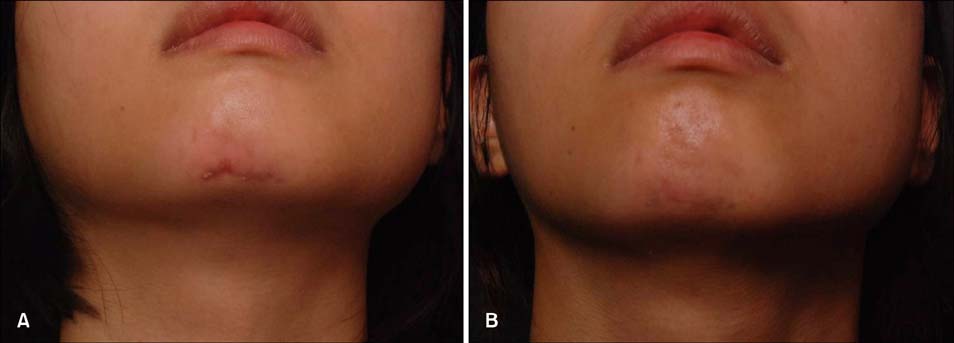Ann Dermatol.
2015 Dec;27(6):756-758. 10.5021/ad.2015.27.6.756.
Combined Treatment with Botulinum Toxin and 595-nm Pulsed Dye Laser for Traumatic Scarring
- Affiliations
-
- 1Yonsei Star Skin and Laser Clinic, Chung-Ang University College of Medicine, Seoul, Korea.
- 2GoodDay Skin and Laser Clinic, Chung-Ang University College of Medicine, Seoul, Korea.
- 3Department of Dermatology, Chung-Ang University College of Medicine, Seoul, Korea. kyky@medimail.co.kr
- KMID: 2157455
- DOI: http://doi.org/10.5021/ad.2015.27.6.756
Abstract
- Traumatic scars on skin covering areas of high movement, especially areas on the face, can be stressful for patients. We report two cases of traumatic scars that occurred on the chin, and that were successfully treated with a combined therapy of 595-nm pulsed dye laser (PDL) and intramuscular injection of botulinum toxin. After the treatment, good cosmetic results were achieved in both patients. The only adverse effect during and after the treatments was mild pain, which resolved within several days without any additional treatment. In conclusion, the combination of 595-nm PDL and intramuscular botulinum toxin injection was shown to be a safe and effective treatment for traumatic scars on the mobile chin area in Korean patients.
Keyword
MeSH Terms
Figure
Reference
-
1. Liu RK, Li CH, Zou SJ. Reducing scar formation after lip repair by injecting botulinum toxin. Plast Reconstr Surg. 2010; 125:1573–1574.
Article2. Wang L, Tai NZ, Fan ZH. Effect of botulinum toxin type A injection on hypertrophic scar in rabbit ear model. Zhonghua Zheng Xing Wai Ke Za Zhi. 2009; 25:284–287.3. Kono T, Erçöçen AR, Nakazawa H, Nozaki M. Treatment of hypertrophic scars using a long-pulsed dye laser with cryogen-spray cooling. Ann Plast Surg. 2005; 54:487–493.
Article4. Ryu HW, Cho JH, Lee KS, Cho JW. Prevention of thyroidectomy scars in Korean patients using a new combination of intralesional injection of low-dose steroid and pulsed dye laser starting within 4 weeks of suture removal. Dermatol Surg. 2014; 40:562–568.
Article5. Kim DH, Ryu HJ, Choi JE, Ahn HH, Kye YC, Seo SH. A comparison of the scar prevention effect between carbon dioxide fractional laser and pulsed dye laser in surgical scars. Dermatol Surg. 2014; 40:973–978.
Article6. Son IP, Park KY, Kim B, Kim MN. Pilot study of the efficacy of 578 nm copper bromide laser combined with intralesional corticosteroid injection for treatment of keloids and hypertrophic scars. Ann Dermatol. 2014; 26:156–161.
Article7. Shaarawy E, Hegazy RA, Abdel Hay RM. Intralesional botulinum toxin type A equally effective and better tolerated than intralesional steroid in the treatment of keloids: a randomized controlled trial. J Cosmet Dermatol. 2015; 14:161–166.
Article8. Chen M, Yan T, Ma K, Lai L, Liu C, Liang L, et al. Botulinum toxin type A inhibits α-smooth muscle actin and myosin II expression in fibroblasts derived from scar contracture. Ann Plast Surg. 2014; DOI: 10.1097/SAP.0000-000000000268. [Epub ahead of print].
Article9. Xiaoxue W, Xi C, Zhibo X. Effects of botulinum toxin type A on expression of genes in keloid fibroblasts. Aesthet Surg J. 2014; 34:154–159.
Article
- Full Text Links
- Actions
-
Cited
- CITED
-
- Close
- Share
- Similar articles
-
- Effective Treatment of Suspicious Riehl's Melanosis Using Low Fluence 1,064 nm Q-switched Nd:YAG Laser and 595 nm Pulsed Dye Laser
- Treatment of Striae Distensae by Thermage and 585-nm Pulsed Dye Laser(V-star(R))
- Pigmentation after Intravenous Iron Injection Treated with 1064 nm Nd:YAG Laser and 595 nm Pulse Dye Laser
- Pulsed Bye Laser Treatment of Anogenital Condyloma Acuminata in a Child
- Nail Psoriasis Treated with 595 nm Pulsed Dye Laser



